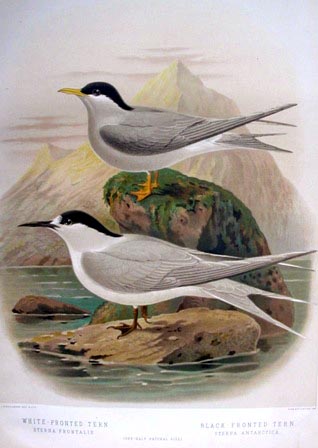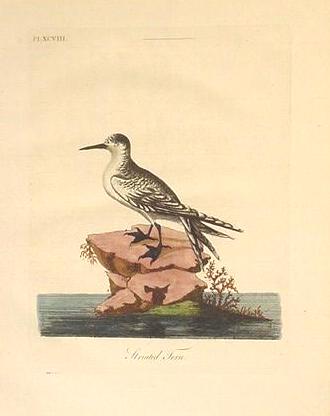
Terns are among the most beautiful of birds and many times around the Bay of Plenty have I observed them; on Ohope Beach where the parents were want to park their juveniles in creches while they hunted for them at sea, mindless of dogs and vehicles, the usual traffic of a busy beach in summer; at Ohiwa Spit where a small colony were inclined to nest with black billed gulls and where I would often observe arctic skuas harrassing them. But, as usual, it it is Guthrie-Smith who writes so sympathetically about these lovely birds.
According to Guthrie Smith, the white-fronted tern, or sea swallow as he was apt to call it, is particular in regard to the ruffling of its plumage by wind. Each individual in the ternery sits facing the breeze. Few sights, he says, are more elegant than such a colony in repose, the beautful birds in hundreds facing one direction, settled into the sand as if floating on water, each with the same pure greys below, the same black cap above, the same dark bill, the same long pinions crossed above the back like the forked tails of a great Brazilean butterfly.
Even during the intervals of calm weather, when not a grain of sand stirs, the first care of a tern reoccupying its nest is the ejection of imaginary grit. Often too, after settling on an egg a bird will as a final touch, gather little billfuls of sand and with jerking movements cast them to right and left.
In watching the busy life of a great ternery, I have often wondered if even under normal conditions each pair of birds always succeeds in rearing its own chick. It is at any rate no infrequent sight to witness a tern settle on a nest apparently its own, driven off that nest by another tern.
Under conditions of storm and stress there are yet stronger reasons for doubting whether each pair of sea swallows rear to maturity their own chick. During rough weather confusion worse confounded reigns. It becomes chaos in the wake of such gales as have been witnessed by me on two occasions on the Porangahau beach. The first was one of those violent dry southers that rush up after sultry weather. In a few moments the whole ternery - the whole beach indeed - was grey with wagging wisps of drift pouring over shore-line hummocks, racing over wet sea sand like dry thin star snow on keen ice.
At any time there is much vociferation amongst a multitude of birds breeding togther; now every bird was doubly noisy and more fiercely on the defensive. Most of the chicks had hatched, but were tiny creatures who lay as minute humps, the sand grit racing over their small bodies. The actual site of the ternery must have been moved some feet or yards northward, and noting the confusion and turmoil, listening to the ceaseless screeching and screaming, and witnessing the indiscriminate celerity with which the homeless chicks sought shelter, it was impossible to believe that many parents remained in possession of their proper offspring.
There are other occasions, too, greater catastrophes by far, which must entail amongst the old birds the keenest competition for surviving nestlings. A heavy sea began late one afternoon to thunder and pound on the beach, and to force an immense weight of water into the lagoon. With the advancing flood the lowest nests were soon engulfed. As the water still continued to rise, first dozens of sitting birds and then hundreds were flooded off their nests. Eggs and chicks were everywhere adrift. The turn of the tide saved the majority of the nests and the sea happened to go down as rapidly as it had risen. Five hundred eggs or tiny chicks had nevertheless perished.

John Latham, striated tern
Other common names: —
Sea swallow
Description: —
Native bird
40 cm., 160 g., adult pale grey or white, long black bill, black or reddish black legs, black cap separated by white forehead.
Where to find: —
Widespread on shore and coastal waters.
Illustration description: —
Buller, Walter Lawry, Birds of New Zealand, 1888.
Latham, John, A General Synopsis of Birds, 1795.
Reference(s): —
Heather, B., & Robertson, H., Field Guide to the Birds of New Zealand, 2000.
Oliver, W.R.B., New Zealand Birds, 1955.
Guthrie-Smith, H., Bird Life on Island and Shore, 1925.
Page date & version: —
Saturday, 7 June 2014; ver2009v1

